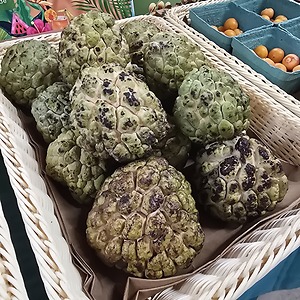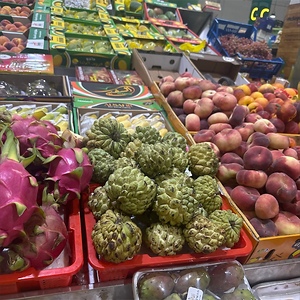


Green Thai Sugar Apple
Estimated Inventory, lb : 0
This item was last sold on : 04/30/24
Description/Taste
Green Thai Sugar apples vary in size, shape, and appearance, depending on the specific variety, and are generally 5 to 20 centimeters in diameter. The fruits showcase a cordate, oval, to oblong shape with broad, curved shoulders tapering to a blunt tip. Sugar apples are a compound fruit made up of carpels that have fused. This composition gives the fruits a scaly, bumpy appearance, and each fruit will vary in its scale-like texture and definition. The fruit’s skin is thin, semi-rough, segmented, and delicate, being easily broken or bruised when ripe. When the fruits are young, the carpels are closely spaced and closed, and as they mature, the bumps will spread apart, making the skin thin and easily punctured. The skin ripens to yellow-green hues, and a yellow coloring should appear between the segments when ripe. The skin is also covered in a grey, powdery bloom. Underneath the surface, the white-to-ivory flesh develops a soft, melting, tender, and succulent consistency when ripe. The flesh glistens when opened and has a custard-like texture with a creamy, granular, and slippery consistency. Black oval seeds are also embedded into the flesh, and depending on the variety, there can be many seeds, or the fruits are seedless. It is important to note that the seeds are inedible and potentially toxic if ingested. Green Thai Sugar apples release a sweet, aromatic scent and will be soft to the touch when ripe. The fruits are traditionally eaten raw, discarding the skin and seeds, and have a tropical, fruity, sweet, floral, and musky taste with vanilla-like undertones.
Seasons/Availability
Green Thai Sugar apples are available year-round in tropical climates. In subtropical climates, the fruits are generally harvested mid-summer through the fall.
Current Facts
Green Thai Sugar apples, botanically classified as Annona squamosa, are a category of tropical fruits belonging to the Annonaceae family. The aggregate fruits grow on deciduous trees or shrubs reaching 3 to 8 meters in height and are harvested as fresh-eating delicacies. Several varieties are generally labeled under the name Green Thai Sugar apple, and distinguishing between the various green-skinned cultivars grown in Thailand is often challenging. Popular varieties include Thai Lessard, Thai Green, Na Dai Sugar apple, Phet Pak Chong, and Kaset Green Sugar apples. Green Thai Sugar apples have also been planted in gardens worldwide, as the fruits are valued for their flavor, texture, and cultivation characteristics. Most Green Thai sugar apple varieties have trees that produce fruits after 1 to 2 years of maturing, and the cultivars are productive and somewhat disease-resistant. Green Thai Sugar apples are grown commercially and in home gardens and are used in beverages, desserts, preserves, and fresh preparations.
Nutritional Value
Green Thai Sugar apples have not been extensively studied for their nutritional properties. Like other types of sugar apples, the fruits may be a source of magnesium to control nerve functions, calcium to build strong bones and teeth, vitamin E to protect the cells against the damage caused by free radicals, and fiber to regulate the digestive tract. The fruits also provide vitamin C to strengthen the immune system, vitamin A to maintain healthy organs, iron to develop the protein hemoglobin for oxygen transport through the bloodstream, potassium to balance fluid levels within the body, and other nutrients, including vitamin B6 and amino acids.
Applications
Green Thai Sugar apples have a sweet, musky, floral, and tropical taste suited for fresh preparations. The fruits are only edible when ripe and are primarily consumed out of hand, discarding the skin and seeds. Green Thai Sugar apples can be easily ripped open by hand when ripe, and the flesh develops a soft, tender, and melting consistency. Sugar apples are traditionally chilled before serving to enhance their refreshing, juicy nature. They are also famously used in ice cream and sherbets in Asia or blended into shakes and smoothies. Try using the flesh in salads, serving as a light dessert, or mix into curries and stir-fries. Green Thai Sugar apples can be used as flavoring in pies, cakes, muffins, and puddings, or they can be mixed into sauces. They are also used as a fresh topping over yogurts, pancakes, waffles, and other breakfast dishes or simmered into jams, jellies, and syrups. Green Thai Sugar apples pair well with fruits such as mangos, strawberries, peaches, and bananas, spices such as cinnamon, cloves, and nutmeg, vanilla, maple syrup, and brown sugar. Whole, unopened sugar apples tend to ripen 3 to 6 days after harvest when stored at room temperature. Once ripe, the fruits should be immediately consumed for the best quality and flavor and will only keep for 1 to 2 days when stored in the fridge.
Ethnic/Cultural Info
Sugar apples are often used in natural medicines throughout Asia. The seeds of the species are poisonous to ingest, but they are used topically and in various home remedies. Oil from the seeds is extracted and used as a natural pesticide, while a paste from the seed is slathered over the scalp to remove lice. Dried, ground, and powdered seeds are utilized as fish poison, and crushed leaves are applied topically to various wounds. Beyond the seeds and leaves, the fruits are edible and are believed to help boost digestion, reduce inflammation, and improve overall complexion. The fruits are also used in home remedies to alleviate colds and other sicknesses.
Geography/History
Sugar apples, a part of the Annona genus, are hypothesized to be native to tropical regions of the Americas, mainly in Central and South America. Much of the genus’ history is unknown, as experts believe the various species were spread throughout Central and South America in ancient times and later traveled to Southern Mexico as the plants were used for their medicinal elements and the fruits as a food source for indigenous peoples. Spanish and Portuguese explorers encountered the fruits in the Americas and spread the genus to Asia, where it was planted in Southern India sometime before 1590, later spreading into Southeast Asia, including Thailand. Annona fruits were also being grown in Indonesia by the early 1600s and expanded in cultivation to the Philippines, China, Australia, and Polynesia. In 1955, species of Sugar apples were carried to the United States, and the seeds were planted on farms in Southern Florida in 1955. Today, Green Thai Sugar apples thrive in tropical lowlands and are cultivated in commercial and home gardens. In Thailand, Green Sugar apples are primarily grown in the Nakhon Ratchasima Province and Phetchabun, and are sold commercially and exported to countries including Vietnam, China, Malaysia, Singapore, and Hong Kong. Some Green Thai varieties are also cultivated in Florida as a specialty cultivar.









